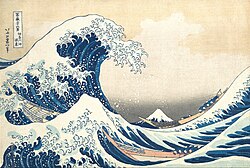East Asian cultural sphere
The East Asian cultural sphere, Sinosphere, or Chinese sphere of influence, is a region in Asia that has many influences from Chinese culture. These including the use of Chinese characters, clothing, art, food, inventions, social structures, government structures, religious ideas, and many other influences. The area is made of the Greater China region (mainland China, Hong Kong, Macau, and Taiwan), Japan, Korea, Singapore, and sometimes Mongolia and Vietnam (depending on who you ask). Since China had a very large trade network, it was able to easily share its goods and ideas across Eurasia, and especially its neighboring countries in East Asia.
At one point, all the countries wrote only using Chinese characters, but nowadays, only Chinese and Japanese speakers write using Chinese characters in everyday life. All the other countries either created a new writing system (Korea and Mongolia), or replaced Chinese characters with a different, already existing writing system (Mongolia, again, and Vietnam). Nonetheless, the languages of each country still have many Chinese loanwords.
East Asian Cultural Sphere Media
Chinese dragons, legendary creatures in Sinosphere mythology and culture
Imperial City, Huế, Vietnam. Chinese architecture has had a major influence on the East Asian architectural styles of Vietnam, Korea, and Japan.
Great Wave off Kanagawa, one of the most famous Japanese woodblock prints
The first line of the Analects of Confucius in Classical Chinese, Standard Chinese, Vietnamese, Japanese, and Korean. Vietnamese is written in chữ Nôm, while Korean in Korean mixed script (한자혼용). Coloured words show vocabulary with the same meaning.
Mahayana Buddhism, a religion particular to the Sinic world
Confucianism plays a crucial part in East Asian culture.
Temple of Literature, Hanoi. Confucian education and imperial examinations played a huge role in creating scholars and mandarins (bureaucrats) for East Asian dynasties.








